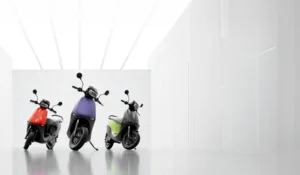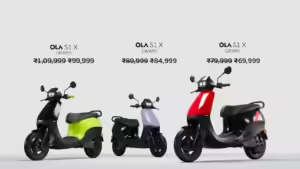Ola Slashes E-Scooter Prices Up to 12.5%s.
Ola Electric, India’s top electric scooter maker, has reduced the price of its most affordable model, the S1X, by 12.5%, bringing it down from ₹79,999 to ₹69,999 ($839). Other S1X variants also saw price cuts between 5.6% and 9.1%. This move comes after the Indian government slashed subsidies for electric two-wheelers, making EVs more expensive for buyers.
Despite launching the S1X series after the subsidy cuts, Ola has further lowered prices to stay competitive. However, some experts worry that this aggressive pricing may not be sustainable, as Ola was already selling higher-end models at a loss. The company remains the market leader, selling 3,26,443 e-scooters in fiscal 2024, surpassing its target of 3,00,000 units. With a 35% market share, Ola is ahead of competitors like TVS (19%) and Ather (12%), offering India’s most affordable electric scooter.
As EV adoption grows, this price drop could boost sales further and strengthen Ola’s dominance in the industry.%.

Ola Slashes E-Scooter Prices Up to 12.5%
India’s leading electric scooter manufacturer, Ola Electric, has announced a significant price cut for its popular S1X model, making eco-friendly mobility more accessible. The base variant of the S1X now starts at ₹69,999 (approximately $839), a 12.5% reduction from its previous price of ₹79,999. Other variants in the S1X lineup have also become more affordable, with discounts ranging between 5.6% and 9.1%. This bold pricing strategy aims to attract budget-conscious buyers and accelerate India’s transition to electric vehicles (EVs).
Defying Subsidy Cuts to Drive EV Adoption
The price reduction comes at a crucial time for India’s EV industry. Earlier this year, the government reduced subsidies for electric two-wheelers under the FAME-II scheme, raising concerns about rising costs for consumers. However, Ola Electric has prioritized affordability, even launching the S1X series after these subsidy cuts. While aggressive pricing could boost sales, industry experts question its long-term sustainability. Reports suggest that Ola has already been selling premium models, such as the S1 Pro, at a loss to gain market share. Lowering prices further for budget models could put additional pressure on profitability unless production costs decrease or sales volumes increase significantly.

Dominating India’s Electric Two-Wheeler Market
Ola Electric’s strategy appears to be strengthening its market dominance. In the 2024 fiscal year, the company sold 3.26 lakh units, surpassing its revised target of 3 lakh scooters. With a 35% market share, Ola leads over competitors like TVS Motor (19%) and Ather Energy (12%). Its success is driven by strategic investments in manufacturing, branding, and a growing network of over 1,000 experience centers across India. Additionally, the company is expanding its battery innovation efforts to reduce dependency on imports and lower costs.
Challenging Petrol Scooters on Price
Ola’s latest move is not just about surpassing EV competitors—it’s a direct challenge to petrol-powered scooters that dominate Indian roads. For instance, the Honda Activa, India’s best-selling petrol scooter, starts at around ₹75,000. By pricing the S1X below ₹70,000, Ola positions its electric model as a more cost-effective alternative, especially when factoring in long-term savings on fuel and maintenance. Currently, electric two-wheelers make up only 5% of India’s overall two-wheeler market, but improved affordability could accelerate their adoption. States like Karnataka, Maharashtra, and Tamil Nadu, where EV infrastructure is expanding, are expected to see the fastest growth.
Consumer Benefits and Industry Impact
For buyers, the price cut means lower upfront costs, which have traditionally been a major barrier to EV adoption. Combined with state-level incentives, reduced GST rates (5% for EVs compared to 28% for petrol vehicles), and lower running costs, Ola’s scooters are becoming an increasingly attractive choice. The company is also enhancing app-based features, such as battery tracking and navigation, to improve the overall user experience.
Challenges Ahead
Despite the optimism, Ola Electric faces significant challenges. Meeting the potential surge in demand will require efficient supply chain management and production scalability. Additionally, concerns about battery longevity and limited charging infrastructure in smaller cities remain barriers to widespread adoption. Meanwhile, established players like Bajaj Auto and Hero MotoCorp are ramping up their EV efforts, potentially leading to intensified price wars in the coming years.
A Catalyst for India’s Green Mobility Goals
Ola’s pricing strategy aligns with India’s broader goal of achieving net-zero emissions by 2070. Affordable EVs are essential for reducing urban pollution and lowering the country’s reliance on fuel imports. If successful, Ola’s approach could inspire similar moves across the industry, pushing electric mobility into the mainstream. However, the challenge lies in balancing aggressive growth with profitability to sustain innovation and market leadership.
Final Thoughts
By slashing prices, Ola Electric is doing more than just selling scooters—it’s driving a fundamental shift in India’s transportation landscape. While risks remain, its aggressive approach could redefine affordability in the EV sector, encouraging millions of Indians to embrace cleaner and more sustainable mobility solutions. As competition intensifies, consumers stand to benefit the most, with better choices and competitive pricing shaping the future of India’s roads.
Check out TimesWordle.com for all the latest news
You must be logged in to post a comment.